CONCEPT18.2 Changes in Earth’s Physical Environment Have Affected the Evolution of Life
As we saw in the previous section, the Phanerozoic eon has been notable for the rapid diversification of multicellular eukaryotes. But the diversity of multicellular organisms has not simply increased steadily through time. New species have arisen, and species have gone extinct, throughout the history of life. Let’s consider some of the physical changes on Earth that have resulted in such dramatic changes in life’s diversity.
The continents have not always been where they are today
The globes and maps that adorn our walls, shelves, and books give an impression of a static Earth. It would be easy for us to assume that the continents have always been where they are. But we would be wrong. The idea that Earth’s land masses have changed their positions over the millennia, and that they continue to do so, was first put forth in 1912 by the German meteorologist and geophysicist Alfred Wegener. His idea, known as continental drift, was initially met with skepticism and resistance. By the 1960s, however, physical evidence and increased understanding of plate tectonics—the geophysics of the movement of major land masses—had convinced virtually all geologists of the reality of Wegener’s vision. Plate tectonics provided the geological mechanism that explained Wegener’s hypothesis of continental drift.
361
Earth’s crust consists of several solid plates. Thick continental and thinner oceanic plates overlie a viscous, malleable layer of Earth’s mantle. Heat produced by radioactive decay deep in Earth’s core sets up large-scale convection currents in the mantle. New crust is formed as mantle material rises between diverging plates, pushing them apart.
Where oceanic plates and continental plates converge, the thinner oceanic plate is forced underneath the thicker continental plate, a process known as subduction. Subduction results in volcanism and mountain building on the continental boundary (FIGURE 18.2A). For example, in the Pacific Northwest of North America, a series of volcanoes formed the Cascade mountain range as the Juan de Fuca oceanic plate has been subducted beneath a portion of the continental North American Plate (FIGURE 18.2B). When two oceanic plates collide, one is also subducted below the other, producing a deep oceanic trench and associated volcanic activity.
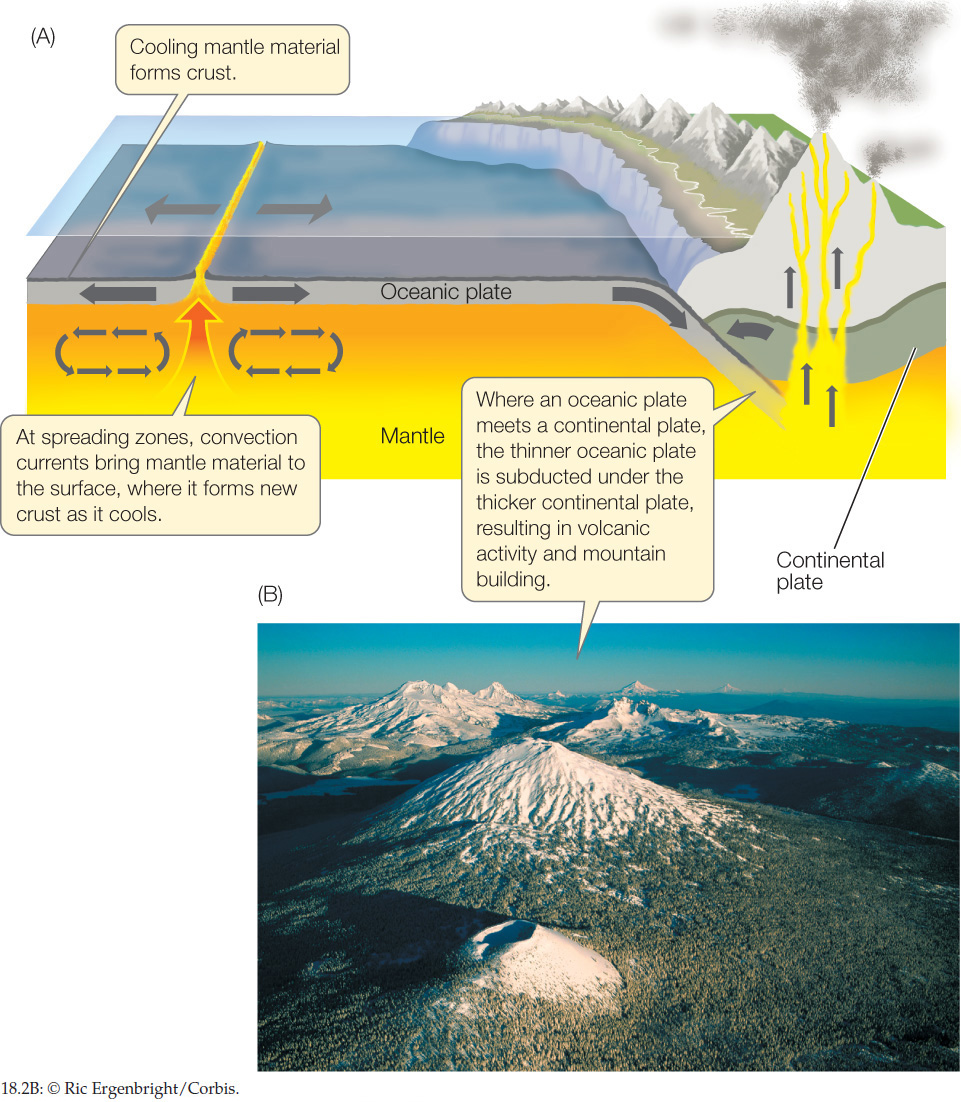
When two thick continental plates collide, neither plate is subducted. Instead, the plates push up against one another, forming high mountain chains. The highest mountain chain in the world, the Himalayas, was formed this way when the Indian Plate collided with the Eurasian Plate. When continental plates diverge, new crust forms in the intervening spaces, resulting in deep clefts called rift valleys in which large freshwater lakes typically form. The Great Rift Valley lakes of eastern Africa, including Lake Malawi (discussed at the opening of Chapter 17), were formed in this way.
Many physical conditions on Earth have oscillated in response to plate tectonic processes. We now know that the movement of the plates has sometimes brought continents together and at other times has pushed them apart, as seen in the maps across the top of Figure 18.12. The positions and sizes of the continents influence oceanic circulation patterns, global climates, and sea levels. Sea levels are influenced directly by plate tectonic processes (which can influence the depth of ocean basins) and indirectly by oceanic circulation patterns, which affect patterns of glaciation. As climates cool, glaciers form and tie up water over land masses; as climates warm, glaciers melt and release water.
Some of these dramatic changes in Earth’s physical parameters resulted in mass extinctions, during which a large proportion of the species living at the time disappeared. These mass extinctions are the cause of the striking differences in fossil assemblages that geologists used to divide the units of the geological time scale. After each mass extinction, the diversity of life rebounded, but recovery took millions of years.
Earth’s climate has shifted between hot and cold conditions
Through much of its history, Earth’s climate was considerably warmer than it is today, and temperatures decreased more gradually toward the poles. At other times, Earth was colder than it is today. Rapid drops in sea levels throughout the history of Earth have resulted mainly from increased global glaciation (FIGURE 18.3). Many of these drops in sea levels were accompanied by mass extinctions—particularly of marine organisms, which could not survive the disappearance of the shallow seas that covered vast areas of the continental shelves.
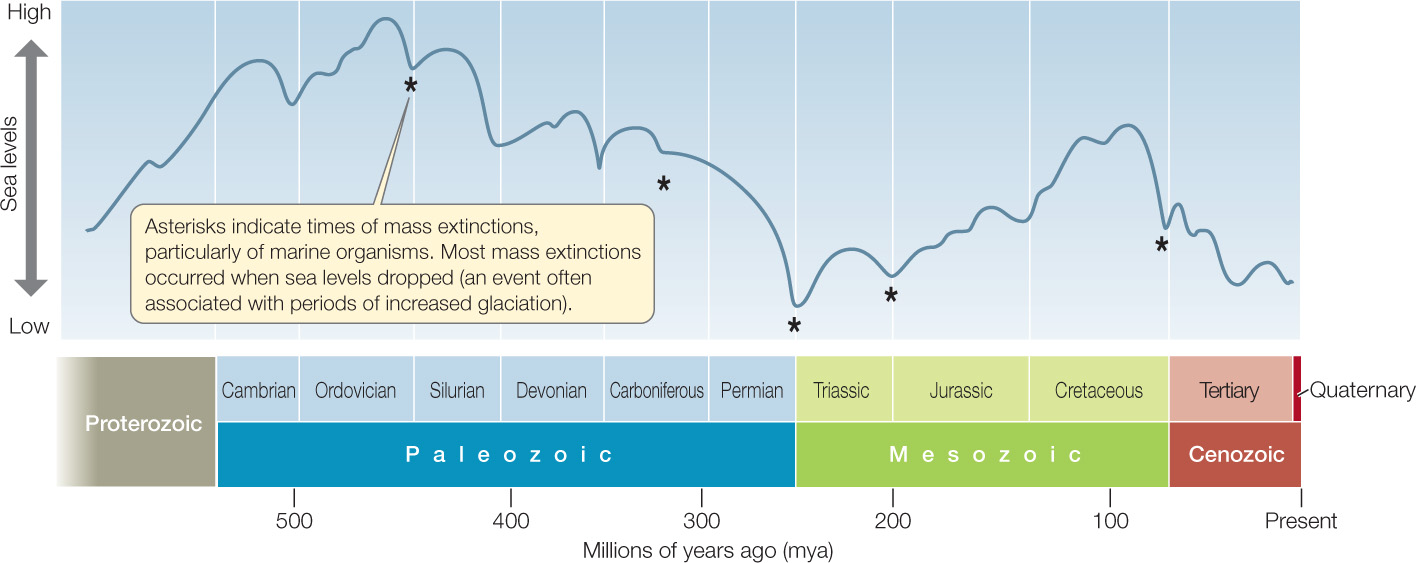
Earth’s cold periods were separated by long periods of milder climates. Because we are living in one of the colder periods, it is difficult for us to imagine the mild climates that were found at high latitudes during much of the history of life. The Quaternary period has been marked by a series of glacial advances, interspersed with warmer interglacial intervals during which the glaciers retreated.
362
“Weather” refers to the daily events at a given location, such as individual storms and the high and low temperatures on a given day. “Climate” refers to long-term average expectations over the various seasons at a given location. Weather often changes rapidly, whereas climates typically change slowly. However, major climate shifts have taken place over periods as short as 5,000 to 10,000 years, primarily as a result of changes in Earth’s orbit around the sun. A few climate shifts have been even more rapid. For example, during one Quaternary interglacial period, the ice-locked Antarctic Ocean became nearly ice-free in less than 100 years. Some climate changes have been so rapid that the extinctions caused by them appear to be nearly instantaneous in the fossil record. Such rapid changes are usually caused by sudden shifts in ocean currents.
We are currently living in a time of rapid climate change thought to be caused by a buildup of atmospheric CO2, primarily from the burning of fossil fuels by human populations. We are reversing the energy transformations accrued in the burial and decomposition of organic material that occurred (especially) in the Carboniferous, Permian, and Triassic, which gave rise to the fossil fuels we are using today. But we are burning these fuels over a few hundred years, rather than the many millions of years over which those deposits accumulated. The current rate of increase of atmospheric CO2 is unprecedented in Earth’s history. A doubling of the atmospheric CO2 concentration—which may happen during the current century—is expected to increase the average temperature of Earth, change rainfall patterns, melt glaciers and ice caps, and raise sea levels.
363
LINK
The consequences of today’s rapid climate changes are discussed in Concept 45.5
Volcanoes have occasionally changed the history of life
Most volcanic eruptions produce only local or short-lived effects, but a few large volcanic eruptions have had major consequences for life. When Krakatau (a volcanic island in the Sunda Strait off Indonesia) erupted in 1883, it ejected more than 25 cubic kilometers of ash and rock, as well as large quantities of sulfur dioxide gas (SO2). The SO2 was ejected into the stratosphere and carried by high-altitude winds around the planet. Its presence led to high concentrations of sulfurous acid (H2SO3) in high-altitude clouds, creating a “parasol effect” so that less sunlight reached Earth’s surface. Global temperatures dropped by 1.2°C in the year following the eruption, and global weather patterns showed strong effects for another 5 years. More recently, the eruption of Mount Pinatubo in the Philippines in 1991 (FIGURE 18.4) temporarily reduced global temperatures by about 0.5°C.
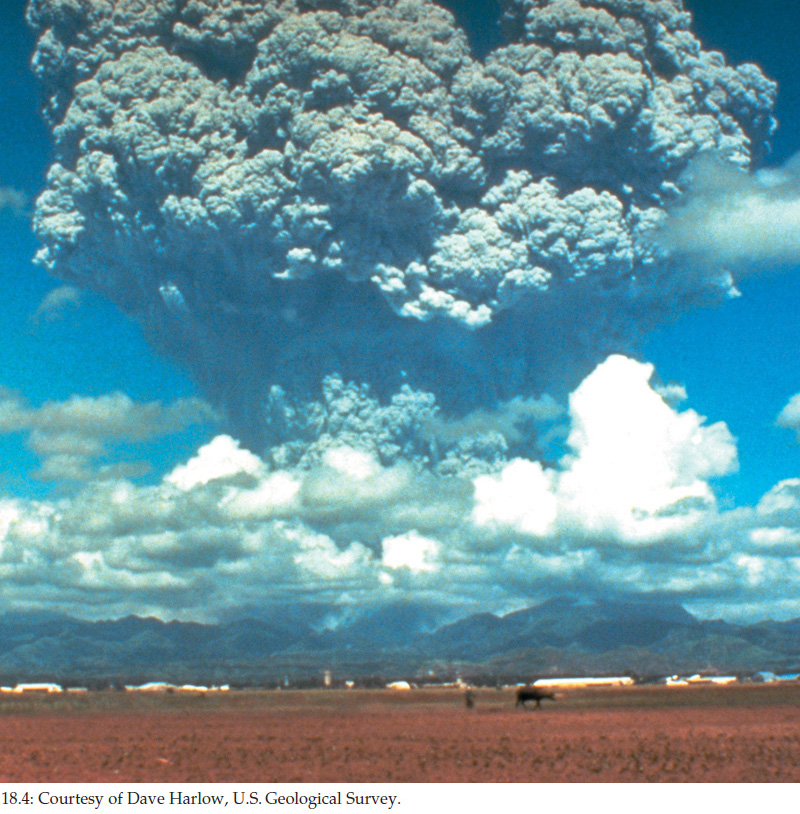
Although these individual volcanoes had only relatively short-term effects on global temperatures, they suggest that the simultaneous eruption of many volcanoes could have a much stronger effect on Earth’s climate. What would cause many volcanoes to erupt at the same time? The collision of continents during the Permian period, about 275 million years ago (mya), formed a single, gigantic land mass and caused massive volcanic eruptions as the continental plates overrode one another (see Figure 18.2). Emissions from these eruptions blocked considerable sunlight, contributing to the advance of glaciers and a consequent drop in sea levels (see Figure 18.3). Thus volcanoes were probably responsible, at least in part, for the greatest mass extinction in Earth’s history.
Extraterrestrial events have triggered changes on Earth
At least 30 meteorites of sizes between tennis and soccer balls strike Earth each year. Collisions with larger meteorites or comets are rare, but such collisions have probably been responsible for several mass extinctions. Several types of evidence tell us about these collisions. Their craters, and the dramatically disfigured rocks that result from their impact, are found in many places. Geologists have discovered compounds in these rocks that contain helium and argon with isotope ratios characteristic of meteorites, which are very different from the ratios found elsewhere on Earth.
A meteorite caused or contributed to a mass extinction at the end of the Cretaceous period (about 65.5 mya). The first clue that a meteorite was responsible came from the abnormally high concentrations of the element iridium found in a thin layer separating rocks deposited during the Cretaceous from rocks deposited during the Tertiary (FIGURE 18.5). Iridium is abundant in some meteorites, but it is exceedingly rare on Earth’s surface. When scientists then discovered a circular crater 180 km in diameter buried beneath the northern coast of the Yucatán Peninsula of Mexico, they constructed the following scenario. When it collided with Earth, the meteorite released energy equivalent to that of 100 million megatons of high explosives, creating great tsunamis. A massive plume of debris rose into the atmosphere, spread around Earth, and descended. The descending debris heated the atmosphere to several hundred degrees and ignited massive fires. It also blocked the sun, preventing plants from photosynthesizing. The settling debris formed the iridium-rich layer. About a billion tons of soot with a composition matching that of smoke from forest fires was also deposited. These events had devastating effects on biodiversity. Many fossil species (including non-avian dinosaurs) that are found in Cretaceous rocks are not found in the overlying Tertiary rocks.
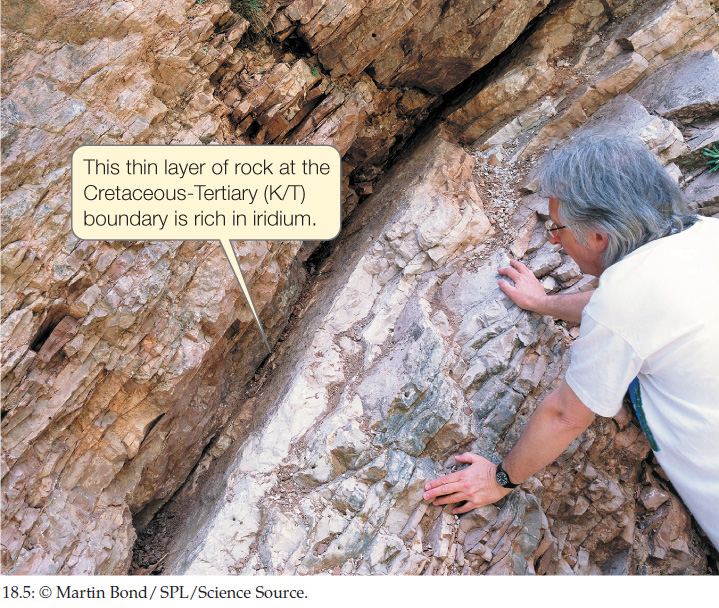
Oxygen concentrations in Earth’s atmosphere have changed over time
As the continents have moved over Earth’s surface, the world has experienced other physical changes, including large increases and decreases in atmospheric oxygen concentrations. The atmosphere of early Earth probably contained little or no free oxygen gas (O2). The increase in atmospheric O2 came in two big steps more than a billion years apart.
364
The first step occurred about 2.5 billion years ago (bya), when the ancestors of modern cyanobacteria evolved the ability to use water as the source of hydrogen ions for photosynthesis. By chemically splitting H2O, these bacteria generated O2 as a waste product. They also made electrons available for reducing CO2 to form the carbohydrate end-products of photosynthesis (see Concepts 6.5 and 6.6). The O2 they produced dissolved in water and reacted with dissolved iron. The reaction product then precipitated as iron oxide, which accumulated in alternating layers of red and dark rock known as banded iron formations (FIGURE 18.6A). These formations provide evidence for the earliest photosynthetic organisms. As photosynthetic organisms continued to release O2, oxygen gas began to accumulate in the atmosphere.
The second step occurred about a billion years later, when a cyanobacteria-like ancestor became symbiotic within eukaryote cells, leading to the evolution of chloroplasts in photosynthetic plants and other eukaryotes. One group of O2-generating cyanobacteria formed rocklike structures called stromatolites, which are abundantly preserved in the fossil record (FIGURE 18.6B). To this day, cyanobacteria still form stromatolites in a few very salty places (FIGURE 18.6C). Cyanobacteria liberated enough O2 to open the way for the evolution of oxidation reactions as the energy source for the synthesis of ATP.
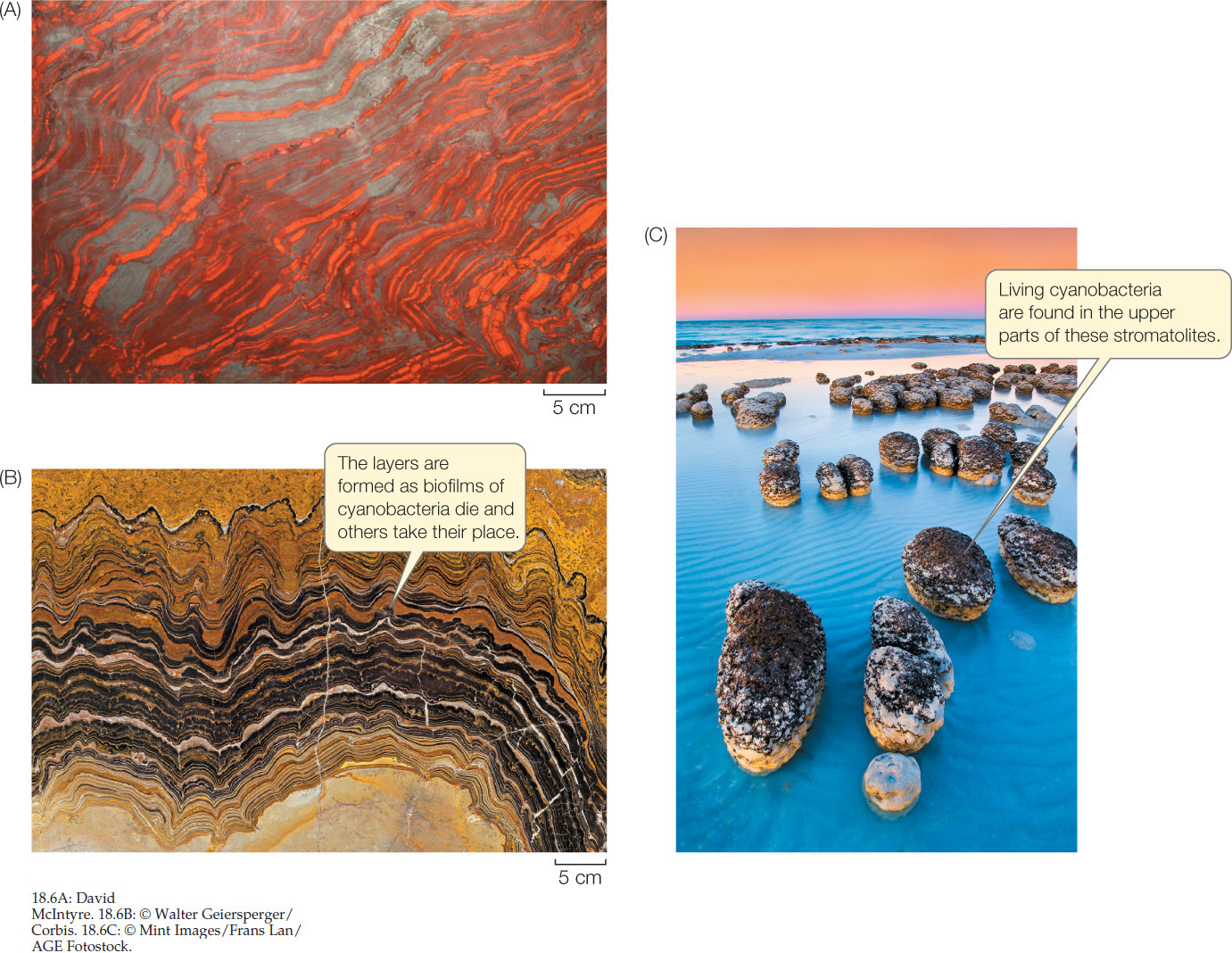
365
Thus the evolution of life irrevocably changed the physical nature of Earth. Those physical changes, in turn, influenced the evolution of life. When it first appeared in the atmosphere, O2 was toxic to most of the anaerobic prokaryotes that inhabited Earth at the time. Over millennia, however, prokaryotes that evolved the ability to tolerate and use O2 not only survived but gained the advantage. Aerobic metabolism proceeds more rapidly, and harvests energy more efficiently, than anaerobic metabolism. Organisms with aerobic metabolism replaced anaerobes in most of Earth’s environments.
An atmosphere rich in O2 also made possible larger and more complex organisms. Small single-celled aquatic organisms can obtain enough oxygen by simple diffusion even when dissolved oxygen concentrations in the water are very low. Larger single-celled organisms, however, have lower surface area-to-volume ratios. To obtain enough oxygen by simple diffusion, larger organisms must live in an environment with a relatively high oxygen concentration. Bacteria can thrive at 1 percent of the current oxygen concentration, but eukaryotic cells require levels that are at least 2–3 percent of the current concentration. For concentrations of dissolved oxygen in the oceans to have reached these levels, much higher atmospheric concentrations were needed.
Probably because it took many millions of years for Earth to develop an oxygenated atmosphere, only single-celled prokaryotes lived on Earth for more than 2 billion years. About 1.5 bya, atmospheric O2 concentrations became high enough for larger eukaryotic cells to flourish (FIGURE 18.7). Further increases in atmospheric O2 concentrations in the late Precambrian enabled several groups of multicellular organisms to evolve.

Oxygen concentrations increased again during the Carboniferous and Permian periods because of the evolution of large vascular plants. These plants lived in the expansive lowland swamps that existed at the time (see Table 18.1). Massive amounts of organic material were buried in these swamps as the plants died, leading to the formation of Earth’s vast coal deposits. Because the buried organic material was not subject to oxidation as it decomposed, and because the living plants were producing large quantities of O2, atmospheric O2 increased to concentrations that have not been reached again in Earth’s history (see Figure 18.7). As mentioned at the opening of this chapter, these high concentrations of atmospheric O2 allowed the evolution of giant flying insects and amphibians that could not survive in today’s atmosphere.
The drying of the lowland swamps at the end of the Permian reduced burial of organic matter as well as the production of O2, so atmospheric O2 concentrations dropped rapidly. Over the past 200 million years, with the diversification of flowering plants, O2 concentrations have again increased, but not to the levels that characterized the Carboniferous and Permian periods.
Biologists have conducted experiments that demonstrate the changing selection pressures that can accompany changes in atmospheric O2 concentrations. When fruit flies (Drosophila) are raised in hyperoxic conditions (i.e., with artificially increased atmospheric concentrations of O2), they evolve larger body sizes in just a few generations (FIGURE 18.8). The present atmospheric O2 concentrations appear to constrain body size in these flying insects, whereas increases in O2 appear to relax those constraints. This experiment demonstrates that the stabilizing selection on body size at present O2 concentrations can quickly switch to directional selection for a change in body size in response to a change in O2 concentrations.
Investigation
HYPOTHESIS
In hyperoxic conditions, increased partial pressure of oxygen results in evolution of increased body size in flying insects.
- Separate a population of fruit flies into multiple lines.
- Raise half the lines in current atmospheric (control) conditions; raise the other lines in hyperoxic (experimental) conditions. Continue all lines for seven generations.
- Raise the F8 individuals of all lines under identical (current) atmospheric conditions.
- Weigh 50 flies from each of the replicate lines and test for statistical differences in body weight.
The average body mass of F8 individuals of both sexes raised under hyperoxic conditions was significantly (P < 0.001) greater than that of individuals in the control lines. Error bars show 95% confidence intervals for the mean (see Appendix B).
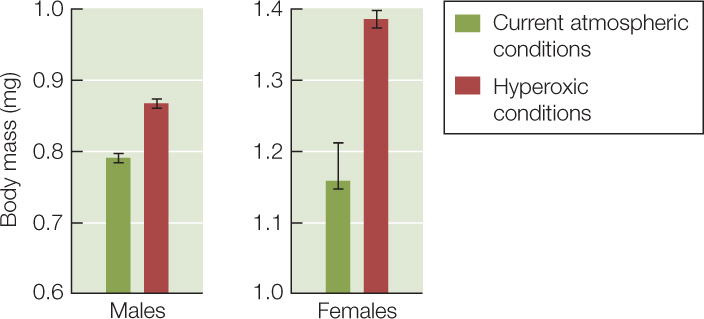
CONCLUSION
Increased O2 concentrations led to evolution of larger body size in fruit flies, consistent with the trends seen among other flying insects in the fossil record.
ANALYZE THE DATA
The table shows the average body masses of the flies raised in hyperoxic conditions in the F0 (i.e., before the first generation in hyperoxia), F1, F2, and F8 generations.
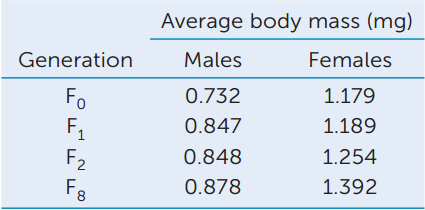
- Graph body mass versus generation for males and females.
- Do the rates of evolution of larger body size appear to be constant throughout the experiment?
- If you doubled the number of generations in the experiment, would you expect the increase in body mass seen under the hyperoxic conditions to double? Why or why not?
aC. J. Klok et al. 2009. Journal of Evolutionary Biology 22: 2496–2504.
LINK
Stabilizing and directional selection are discussed and compared in Concept 15.4
366
CHECKpointCONCEPT18.2
- How have volcanic eruptions and meteorite strikes influenced the course of life’s evolution?
- Explain why an occasional major winter blizzard is irrelevant to discussions of global climate warming.
- Research and explain the different climatic responses to the “parasol effect” of major volcanic eruptions and the “greenhouse effect” of long-term CO2 emissions. What is the fundamental difference in the two effects?
- How have increases in atmospheric concentrations of O2 affected the evolution of multicellular organisms?
The many dramatic physical events of Earth’s history have influenced the nature and timing of evolutionary changes among Earth’s living organisms. We will now look more closely at some of the major events that characterize the history of life on Earth.
Changes in Earth’s physical environment have affected the evolution of life
In the experiment shown in Figure 18.8, body mass of individuals in the experimental population of Drosophila increased (on average) about 2% per generation in the high-oxygen environment (although the rate of increase was not constant over the experiment). What rate of increase in body mass per generation would be sufficient to account for the giant dragonflies of the Permian?
- Assume that the average rate of increase in dragonfly size during the Permian was much slower than the rate observed in the experiment in Figure 18.8. We’ll assume that the actual rate of increase for dragonflies was just 0.01% per generation, rather than the 2% observed over a few generations for Drosophila. We’ll assume further that dragonflies complete just one generation per year (as opposed to 40 or more generations for Drosophila). Starting with an average body mass of 1 gram, calculate the projected increase in body mass over 50,000 years.*
- What percentage of the Permian period does 50,000 years represent? Use Table 18.1 for your calculation.
- Given your calculations, do you think that increased oxygen concentrations during the Permian were sufficient to account for the evolution of giant dragonflies? Why or why not?
*This calculation is similar to computing compound interest for a savings account. Use the formula W = S (1 + R)N, where W = the final mass, S = the starting mass (1 gram), R = the rate of increase per generation (0.0001 in this case), and N = the number of generations.
367